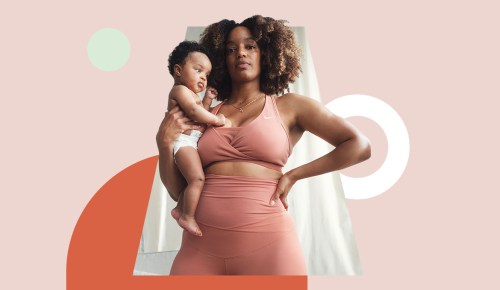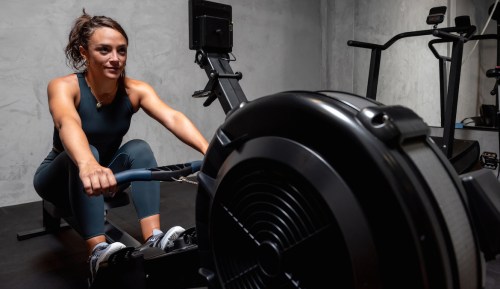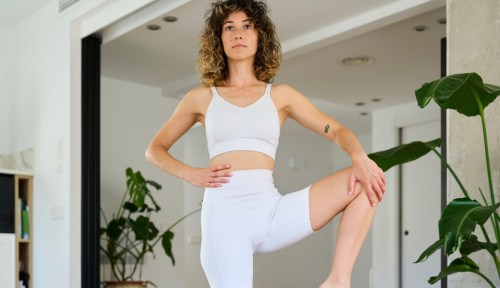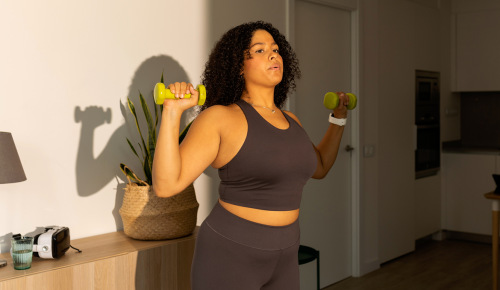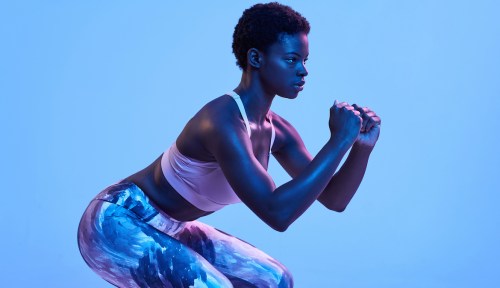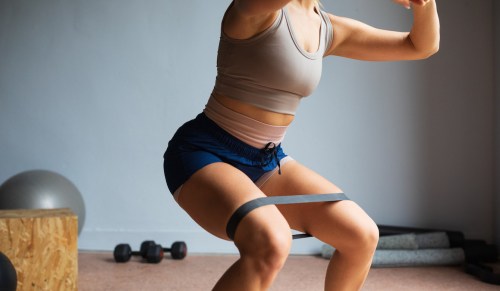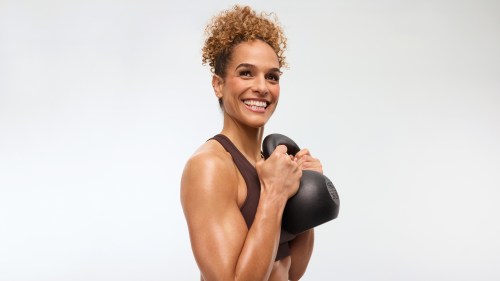It’s common courtesy on the subway to give up your seat to someone who is visibly pregnant. Though considerate, the move could have an outdated implication: That they are not physically fit enough to move about the world.
Experts in This Article
chief physical therapist at P.volve
NASM-certified personal trainer with specializations in women’s fitness, pre/postnatal, nutrition, and therapeutic exercise
A professor at California State University Long Beach who has studied the history and commodification of the body
While that may have been society’s attitude for a long time, a different perspective is gaining steam—one that appreciates the strength required for childbirth and parenting. Pre- and postnatal workout classes are now common in the fitness industry, with a recent surge thanks to a confluence of scientific and societal shifts.
“The truth is that we have tomove throughout our daily lives while we are pregnant,” says Amy Hoover, the resident doctor of physical therapy at P.volve, a functional fitness method designed for women. “While it is true that our bodies rapidly change andadjustment is needed, life and daily activity does not need to stop because we are pregnant.” Exercise not onlysupports better movement in changing bodies, but can provide multiple benefits, likeeasing musculoskeletal pain, improving constipation, reducing the risk for gestational diabetes, and more.
In 2002, the American College of Obstetrics and Gynecology put out guidance that 30 minutes of exercise per day was safe for pregnant people. But over the next two decades, the science went on to show that not only was exercise safe, it was beneficial, says Salena Zanotti, MD, an OB/GYN with the Cleveland Clinic. So in 2020, ACOG went a step further and issued updated guidance on the topic of pregnancy and exercise, recommending that people experiencing normal pregnancies get exercise.
In the intervening years, we saw a pregnant Beyoncé riding front row at SoulCycle, we watched Charlotte York in the Sex and the City movie reclaim her relationship with running while pregnant, and we followed countless celebrity pregnancy fitness journeys on Instagram.
But since ACOG’s guidance changed around the same time that the fitness industry itself got a (digital) overhaul thanks to the pandemic, gyms, virtual studios, and fitness apps have been rolling out maternity fitness programs designed to serve people before, during, and after pregnancy at a record clip. In May, Nike released the 48-week (M)ove Like a Mother prenatal and postpartum program on its hugely popular Nike Training Club app. The prior month, Apple Fitness+ debuted a postpartum training plan after posting its own prenatal plan in 2021. Kayla Itsines’s Sweat and Body By Simone also announced new offerings in recent months, and The Class has even released a fertility series to support people who are trying to get pregnant.
Of course, prenatal yoga and moderate aerobic exercise have been common for decades, but the taboo around higher intensity exercises like strength training appears to be finally dissipating, if the catalogue of Nike and Apple Fitness+ classes are any indication. It’s become widely accepted that it’s generally okay for pregnant people to continue doing activities they did before, making adjustments as the pregnancy progresses.
“The fitness industry has made gigantic leaps in improving offerings for pregnant women and new moms,” says Rachel Trotta, a certified personal trainer who specializes in pre/postnatal fitness. “As a culture, we’re evolving past the fear that exercise could be potentially harmful during pregnancy, and we’re recognizing the well-researched benefits.”
And people are taking advantage of the offerings: Over the course of 2022, MindBody says that bookings of prenatal fitness classes on ClassPass have increased over 50 percent. Maternal fitness is having its moment.
Why pregnancy-focused fitness is surging
Over the last two and a half pandemic years, the fitness companies that have been able to tailor workouts to their audiences have swum, while those that did not adapt to the highly personalized digital landscape sunk. At the same time, all of us—pregnant or not—have started to pay more attention to our health and physical fitness.
“Wellness and prevention are huge right now, especially since the pandemic,” says Hoover. “People are taking their health more seriously and doing their own research to better themselves. This means they are looking to be more active in every phase of life,” including pregnancy.
Previously, pregnant people were seen as idealized, delicate vessels whose sole purpose was to bring new life into the world, says Sarah Schrank, PhD, a professor at California State University Long Beach who has studied the history and commodification of the body. Hoover adds that this attitude manifested in supposedly chivalrous norms like pregnant people being told not to lift simple things like groceries or being “treated as though she should not be doing normal, daily things.”
The fact that these new workout programs are meant to serve pregnant people themselves—and not just the fetuses they are carrying—shows that those attitudes may be changing. As the science has advanced, the pregnant body has become celebrated for its strength, and treated as more than just a baby carrier to be careful with.
The benefits of working out while pregnant
Today, doctors acknowledge that not only is exercise safe during pregnancy, it is essential. “It is important to be as healthy as one can be [during pregnancy] and exercise is an important aspect of being healthy,” Dr. Zanotti says.
ACOG advises that “regular exercise during pregnancy benefits you and your fetus” in a multitude of ways, including reduced back pain, eased constipation, strengthening overall fitness including your heart and blood vessels, and it “may decrease your risk of gestational diabetes, preeclampsia, and cesarean birth.” During her own pregnancy in 2020, Trotta says that a regimen of frequent short walks and at-home strength training helped her “keep back pain at bay, maintain flexibility and mobility, and even avoid classic pregnancy swelling.”
Moreover, exercise is shown to be good for your mental health, which many people struggle with during and after pregnancy. “It’s empowering,” Dr. Schrank says. “It makes women feel less alienated from their bodies.”
Yet Dr. Zanotti notes that ACOG’s exercise recommendations are for normal, low-risk pregnancies, and that all pregnant people should consult their medical providers about their workout regimens. Exercise should be avoided in “cases of uteroplacental insufficiency, bleeding, placenta issues (such as a previa), rupture of membranes, and any maternal conditions, such as heart disease,” she cautions.
Where the maternal fitness boom falls short
Our society at large, and the fitness industry specifically, does not have the greatest track record with how it treats the choice of bringing new life into the world—just look at how athletes who get pregnant have been treated by sponsors in the past.
As a culture, “we have so much ambivalence around the maternal body,” Dr. Schrank says. “Capitalism loves ambivalence, because you can always sell things to people when they’re anxious.” Both women and men are uncomfortable with the idea that a body changes when it’s pregnant, manifested in the reality of the bump and bigger body, because, as Dr. Schrank puts it, “Pregnancy: Good, but Fatness: Bad.”
“We’re under so much pressure to have just a certain shape as women in a sexist, misogynist culture,” Dr. Schrank says. “Suddenly your body’s changing, and you’re either fetishized for your Madonna role, or you just feel fat and gross. That’s terrible. And so exercise then becomes this way of mediating those things and that’s not so great either. Like maybe it’s okay to like, just rest and eat Doritos. Like, maybe that’s okay.”
It’s possible that the expansion of maternal fitness programs is playing on the worry that there might be a right way and a wrong way to get bigger—Pregnant, but not Fat. The ACOG guidelines even put this anxiety on display when it lists “promotes healthy weight gain during pregnancy” and “helps you to lose the baby weight after your baby is born” as benefits of exercise.
Could maternal exercise programs be adding yet another fat-phobic “should” to a biological process already wrought with dos and don’ts? Dr. Zanotti doesn’t think this is the case, because of how important exercise is for a healthy pregnancy. But Dr. Schrank worries the increase of pre- and postnatal fitness may put more expectations on pregnant people, especially when it comes to losing baby weight.
“We could still do a better job of making exercise less about ‘fitness,’ baby weight, and arbitrary standards, and more about movement, quality of life, and stress reduction,” Trotta says. Fortunately, many trainers (though not all) have navigated these waters deftly, focusing on the functional fitness needed for handling a baby, and how the new mom feels.
Clearly, companies are making these pregnancy programs because they have the potential to acquire new customers. Making money doesn’t necessarily mean a company’s intentions are bad, but the venture is obviously a new revenue stream, not just an offering out of the goodness of their hearts.
“Now you can sell people clothes to make you look cuter, or classes to make you feel better,” Dr. Schrank says. “It’s endless, how much stuff can be sold.”
And some of what’s being sold can feel a little fishy. Though trainer certification organizations offer pre- and postnatal certifications—which trainers pay hundreds of dollars to add to their credentials—Dr. Zanotti notes that there is “no official licensing for pregnancy trainers.” That is, a trainer may say they’re “pre/postnatal certified,” but that certification did not come with the stamp of approval from a medical organization, like ACOG. This means advertising that highlights trainers with these credentials is little more than marketing. Moreover, it isn’t a clear sign of true medical oversight, like input from an OB/GYN.
Still, as imperfect as some of today’s options may be, they offer pregnant people more choice and agency over their bodies than they’ve maybe ever had. If the fitness industry can steer clear of problematic messaging about the need to constantly perfect our bodies, and offer truly safe, doctor-approved programs, the maternal fitness boom can be a win for moms.
Sign Up for Our Daily Newsletter
Get all the latest in wellness, trends, food, fitness, beauty, and more delivered right to your inbox.
Got it, you've been added to our email list.
